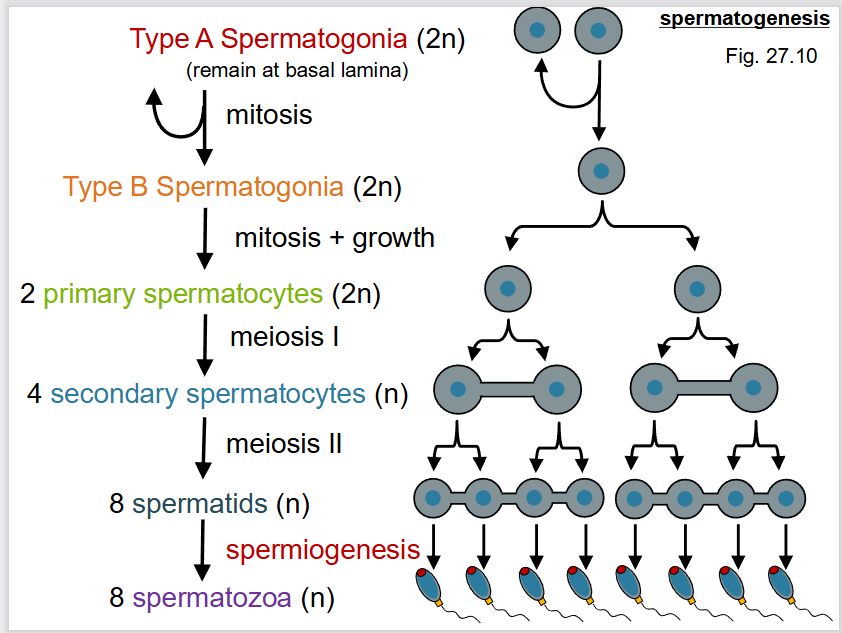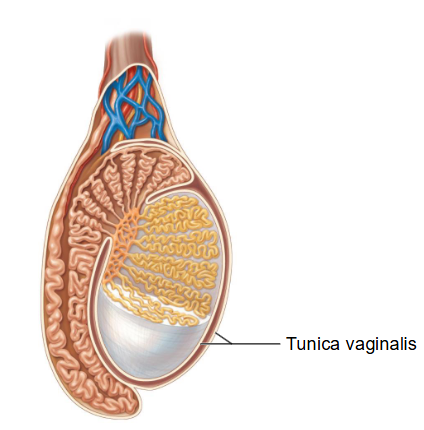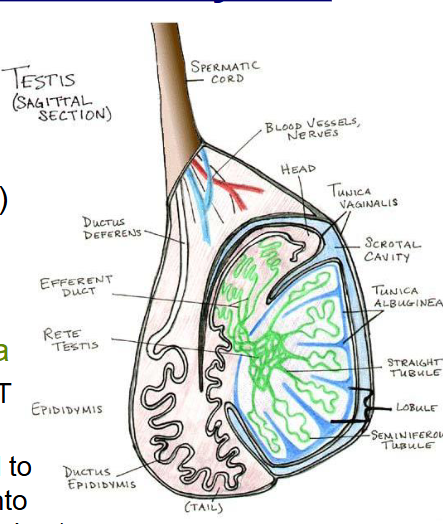-
What do gonads do?
o produce gametes and hormones
-
What do accessory glands do?
o produce secretions that support the gametes
-
What do ducts do?
o transport and store gametes
-
What are the testicular reproductive system structures?
gonads (testes), ducts, penis, and accessory glands
-
What are testes anatomically?
- located within the scrotum (skin and connective tissue)
- surrounded by two layers (tunics): tunica vaginalis and tunica albuginea
- two lobules
-
What is the tunica vaginalis layer of the testes anatomically?
outer (superficial) layer
serous membrane derived from peritoneum
-
What is the tunica albuginea layer of the testes anatomically?
inner fibrous connective tissue capsule
extends inward to divided testis into lobules (small lobes)
-
What does each lobule of the testes contain?
seminiferous tubules and Interstitial endocrine (Leydig) cells
-
What do seminiferous tubules do?
produce sperm (spermatogenesis)
tubules unite to form rete testis on posterior side of each testis (rete = network)
-
What are the walls of the seminiferous tubules composed of?
spermatogenic cells and sustentocytes (nurse) cells
-
What are sustentocytes (nurse) cells?
surround, nourish and protect developing gametes
extend from basement membrane to lumen
are connected to one another by tight junctions that form the blood-testis barrier which protects developing sperm from immune system, toxins and drugs
produce testicular fluid for sperm transport in tubule lumen
-
What are spermatogenic cells?
germ cells in various stages of development that will become sperm
-
What are Interstitial endocrine (Leydig) cells?
in connective tissue between seminiferous tubules
secrete testosterone (hormone)
-
How are ducts relevant to the male reproductive system?
Sperm formed in the seminiferous tubules enter the rete testis, and then move into a series of ducts
-
What are the ducts in the series of ducts sperm move through?
epididymis, vas (ductus) deferens, ejaculatory duct, urethra
-
What is the epididymis duct?
posterior border of testis
site of sperm storage and maturation (develop ability to swim)
-
What does the Vas (ductus) deferens duct do?
transports sperm from the epididymis during ejaculation
part of the spermatic cord which carries the vas deferens, nerves, blood supply, lymphatic vessels through the body wall
enters anterior pelvic cavity and loops over posterior wall of bladder
-
what is the ejaculatory duct formed by?
formed by union of vas deferens and duct from seminal vesicle
-
What does the urethra duct do?
transports urine and semen out of the body
has 3 regions: prostatic urethra, intermediate (membranous) urethra, and spongy (penile) urethra
-
What are the 3 regions of the urethra and what do they do?
- prostatic urethra: runs through prostate gland
- intermediate (membranous) urethra: runs through the urogenital diaphragm (muscular floor of pelvis)
- spongy (penile) urethra: runs through the corpus spongiosum of the penis and ends at an opening at the tip of the glans penis called the external urethral orifice
-
What is the penis anatomically?
- urinary and copulatory organ
- parts: Root, Body (shaft), Glans penis (enlarged tip)
- has three cylindrical bodies of erectile tissue (blood sinuses bound by connective tissue)
-
What are the three cylindrical bodies of erectile tissue?
- 2 corpora cavernosa: dorsal/posterior (in the erect position), form most of the root and shaft
- 1 corpus spongiosum: midventral/anterior (in the erect position), surrounds urethra and forms the glans penis
-
What do the accessory glands do?
contribute secretions during sexual arousal
~95% of semen comes from the following glands, listed in order of highest to lowest contribution: seminal vesicles (2), prostate gland (1), bulbourethral glands (2)
-
Where are the seminal vesicles? What do they do?
posterior to bladder
secrete a fluid that provides sperm with a source of nutrients
-
Where are the prostate glands? What do they do?
- inferior to bladder and encircles prostatic urethra
- secretes a fluid that nourishes and activates sperm motility
-
Where are the bulbourethral glands? What do they do?
below prostate in urogenital diaphragm (in contact with external urethral sphincter)
secretes thick mucus that helps lubricate the urethra and the glans penis
-
What is spermatogenesis?
- refers to sperm production within the seminiferous tubules
-
What is spermiogenesis?
- a part of spermatogenesis: is the differentiation of the spermatids into sperm
o develop flagella and acrosomes
o lose most cytoplasm
-
What is the process of spermatogenesis?

-
What is the structure of spermatozoa?
- Head: nucleus (23 chromosomes (n)), top of nucleus is covered by the acrosome
- Body (midpiece): contains a large number of mitochondria that produce the ATP required for movement
- Tail = flagellum: propel sperm, made of microtubules
-
What is acrosome?
- head of sperm cell
- a modified lysosome
- contains enzymes required to penetrate secondary oocyte
-
What is semen?
o sperm and testicular fluid (5%), and accessory gland secretions (95%)
o 2-5mL released during ejaculation (contains 20-150 million sperm/ml)
o pH is slightly alkaline = 7.2 – 7.6
o provides sperm with transportation medium, nutrients, and protection
-



